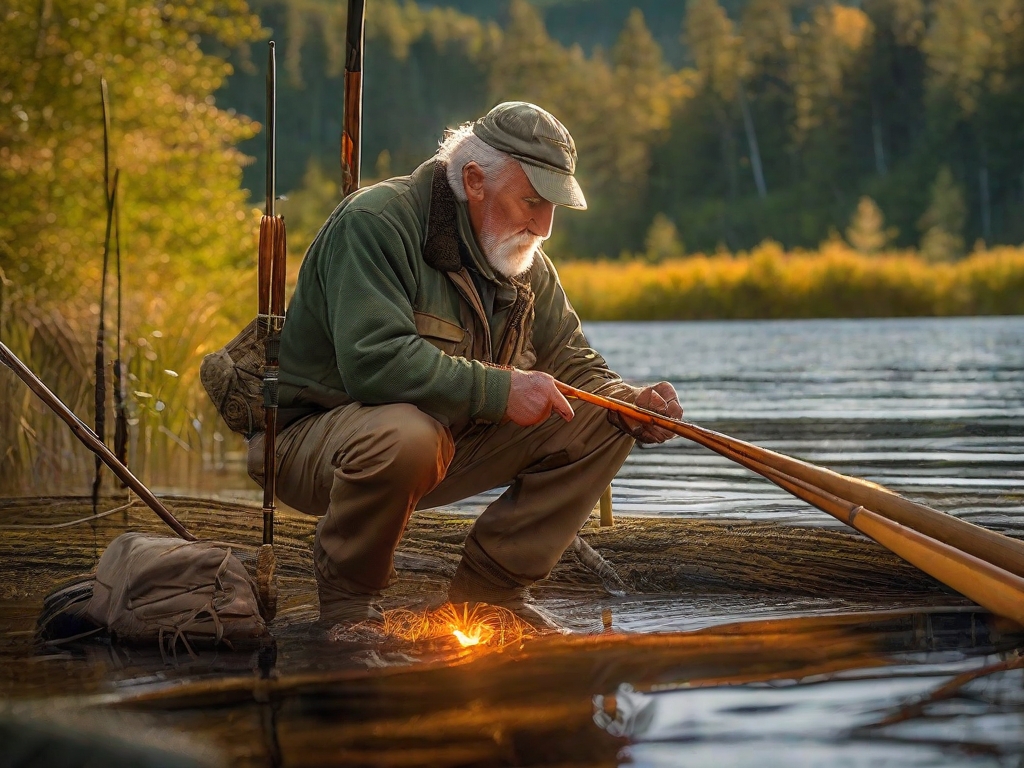
Materials Needed
To make a fishing spear, you will need a few key materials. Firstly, you will need a wooden pole. Look for a sturdy pole that is about one to two meters long and has a diameter of at least two inches. Next, you will need a knife or machete to shape and carve the wood. Additionally, you will need cord or rope to create a grip on the spear. Lastly, you will need a metal or sturdy object to create the spear tip. This can be a sharpened piece of metal or even a durable rock. Optional materials include a fire source to fire-harden the pole for added strength.Preparing the Wooden Pole
Before you begin creating your fishing spear, it is important to properly prepare the wooden pole. Start by selecting the right size and type of wood. Look for a hardwood species such as oak, hickory, or ash, as these woods tend to be more durable and less prone to splintering. Once you have your wooden pole, remove any branches or knots using your knife or machete. Next, smooth out the surface of the pole by gently carving away any rough areas. This will ensure a comfortable grip and reduce the risk of splinters. If desired, you can also fire-harden the pole by exposing it to direct flame. This process will make the wood tougher and less susceptible to damage.

Creating the Speartip
The speartip is a crucial component of a fishing spear. There are several options for creating a speartip, depending on the materials available to you. One option is to choose a metal object, such as a knife blade or a sharpened metal rod, to use as the tip. Shape the metal to a point and ensure it is securely attached to the pole. Another option is to carve a wooden tip if metal is not available. Use your knife or machete to shape the wooden tip to a sharp point and securely attach it to the pole using cord or rope. Whichever option you choose, it is important to create a sturdy and sharp speartip to maximize your chances of success.Adding Grip
Having a secure and comfortable grip on your fishing spear is essential for accuracy and control. Start by determining the ideal location for your grip based on your reach and personal preference. Next, create indentations or grooves in the wood to improve your grip. Use your knife or machete to gently carve the surface of the handle, ensuring the grooves are not too deep to compromise the strength of the pole. Once the grooves are in place, tightly wind the cord or rope around the handle, creating a textured grip. This will provide additional traction and improve your overall control of the spear.Sharpening the Tip
To increase the effectiveness of your fishing spear, it is important to have a sharp and precise speartip. Begin by using a file or sharpening stone to sharpen the edges of the speartip to a point. Be cautious and take your time to ensure a consistent and symmetrical shape. After sharpening, carefully test the sharpness of the tip by gently pressing it against a solid surface. If it easily bites into the material, your speartip is sharp enough for successful fishing. However, if it fails to penetrate or slides off, further sharpening is required.Strengthening the Spear
While crafting your fishing spear, it’s important to assess and strengthen any weak spots that may compromise its effectiveness and durability. Inspect the entire length of the pole for any cracks, splintering, or structural weaknesses. If you identify any weak spots, you can reinforce them by adding extra support or bindings. This can be done by wrapping cord or rope tightly around the weakened area or using adhesive materials to provide additional support. Additionally, ensuring proper balance and weight distribution along the spear will enhance its performance and ease of use.
Testing and Practicing
After constructing your fishing spear, it is crucial to spend time testing and practicing with it. Practicing the proper throwing technique will greatly improve your accuracy and range. Experiment with different techniques to find the throwing method that works best for you. It’s also important to test the spear’s accuracy and range by targeting specific points or objects. Adjust the grip or weight of the spear as needed to fine-tune its performance. Regular practicing and testing will make you more proficient in using your fishing spear.Using Safety Precautions
When using a fishing spear, it’s essential to prioritize safety. Always be aware of your surroundings and any potential hazards. Ensure there is ample space around you to safely throw the spear without endangering others or damaging property. When handling the spear, exercise caution to avoid injury. Keep the spear pointed away from yourself and others, and never throw it recklessly or in an uncontrolled manner. Additionally, use the spear responsibly and ethically, respecting local fishing regulations and practices.Optimizing for Fishing
To optimize your fishing spear for success, it’s important to consider the specific needs of fishing. Choose appropriate fishing locations, such as shallow waters or areas with high fish activity. Understanding fish behavior and habitats will increase your chances of a successful catch. Consider adjusting the size and weight of your spear according to the fish species you are targeting. Smaller fish may require a lighter spear, while larger species may need a heavier one. Adapting your fishing spear to suit the specific conditions will enhance your fishing experience.Can a Solar Still Be Used to Purify Water for Fishing?
Yes, a solar still can be used to purify water for fishing. By harnessing the power of the sun, a build solar still converts contaminated water into potable water suitable for fishing purposes. The process involves heating the water, condensing the vapor, and collecting the purified liquid, removing impurities and ensuring safe drinking water while enjoying a day of fishing.
Maintaining and Storing
To prolong the lifespan of your fishing spear and ensure its continued effectiveness, proper maintenance and storage are crucial. After each use, clean the spear by removing any debris and drying it thoroughly to prevent rusting. Inspect the spear for any signs of damage or wear and take appropriate measures to repair or replace any compromised components. Finally, store the spear in a safe and secure location to prevent potential damage or accidents. Proper maintenance and storage practices will ensure your fishing spear remains in optimal condition for future fishing adventures. In conclusion, crafting your own fishing spear can be a rewarding and practical way to enhance your fishing experience. By selecting the right materials, preparing the wood, creating a sharp speartip, adding grip, and ensuring strength and balance, you can create a reliable fishing tool. Remember to test and practice with your spear, prioritize safety precautions, optimize for fishing success, and properly maintain and store your spear. With your homemade fishing spear in hand, you can enjoy the thrill and satisfaction of catching fish in a more traditional and hands-on way. Happy fishing!
I’m Alex, the author behind True Survivalist. As a survival enthusiast myself, I’ve created this website to serve as a valuable resource for fellow survivalists and preppers. Whether it’s understanding survival situations, emergency preparedness, or finding the right survival gear, I’ve got you covered. Through a series of informative guides, I aim to provide answers to commonly asked questions, debunk common myths, and help you avoid common mistakes. At True Survivalist, I believe in equipping you with the knowledge and tools you need to be prepared for any survival scenario. Join me on this journey of self-reliance and resilience.
